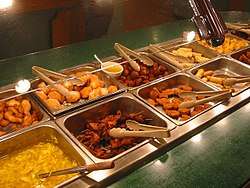Chinese restaurant

A Chinese restaurant is an establishment that serves Chinese cuisine outside China. Most of them are in the Cantonese restaurant style, often adapted to local preferences, as in the American Chinese cuisine and Canadian Chinese cuisine. The Chinese restaurants in the Netherlands usually combine Cantonese and Indonesian meals on their menu. Chinese takeouts (United States and Canada) or Chinese takeaways (United Kingdom and Commonwealth) are also found either as components of eat-in establishments or as separate establishments, and serve a take out version of Chinese cuisine.
History
United States
Chinese restaurants in the United States began during the California gold rush, which brought twenty to thirty thousand immigrants across from the Canton (Guangdong) region of China. The first documented Chinese restaurant opened in 1849 as the Canton Restaurant.[1] By 1850, there were five restaurants in San Francisco. Soon after, significant amounts of food were being imported from China to America's west coast. The trend spread eastward with the growth of the American railways, particularly to New York City.[2] At the ratification of the Chinese Exclusion Act of 1882 there were only 14 restaurants in San Francisco.[3] However, the Chinese Exclusion Act allowed merchants to enter the country, and in 1915 restaurant owners became eligible for merchant visas. This fueled the opening of Chinese restaurants as an immigration vehicle.[4] As of 2015, the United States had 46,700 Chinese restaurants.[5]
There has been a consequential component of Chinese emigration of illegal origin, most notably Fuzhou people from Fujian Province[6] and Wenzhounese from Zhejiang Province in Mainland China, specifically destined to work in Chinese restaurants in New York City, beginning in the 1980s. Adapting Chinese cooking techniques to local produce and tastes has led to the development of American Chinese cuisine. Many of the Chinese restaurant menus in the U.S. are printed in Chinatown, Manhattan,[7] which has a strong Chinese-American demographic.
United Kingdom
In 1907, the first recorded Chinese restaurant in London, England was opened.[8] The rise in the number of Chinese restaurants in the UK only began after the Second World War, and has been attributed to returning service personnel.[9] The restaurants were operated by Hong Kongers who moved to the UK.[10] One restaurant that stands out in the history of Chinese restaurants in the UK is the Kuo Yuan which in 1963 was the first restaurant to serve Peking duck.
In 2003, the first British Chinese restaurant achieved a Michelin star.[11] In the United Kingdom, the business employed a large percentage of Chinese immigrants in the 1980s (90% in 1985).[12] Opening a restaurant or takeaway gave a relatively low capital cost entry for Chinese families into self-employment.[13] Many takeaways served a pseudo-Chinese cuisine based around western tastes, and the limited cooking skills and experience of the shop owners.[13][14]
Australia
At the beginning of the 21st century, Chinese restaurants had been present in a significant majority of Australian cities and towns for over fifty years, and in many places for over one hundred and fifty years.[15]
They emerged as commercial enterprises on the Victorian gold fields.[16]
The significant majority of original Chinese migration came from Kwangtung Province in southern China, heavily influencing the style of food, consisting of fresh vegetables and fruit, with fish, poultry, and pork, with rice, hebs and spices.[17]
One third of all cooks in Australia were chinese by 1890.[15][18]
See also
References
| Wikimedia Commons has media related to Chinese style restaurants. |
- ↑ LIU, HAIMING; Ling, Huping (2015). From Canton Restaurant to Panda Express: A History of Chinese Food in the United States. Rutgers University Press. ISBN 9780813574752.
- ↑ Smith, Andrew F. (1 October 2009). Eating history: 30 turning points in the making of American cuisine. Columbia University Press. p. 47. ISBN 978-0-231-14092-8. Retrieved 22 June 2011.
- ↑ LIU, HAIMING; Ling, Huping (2015). From Canton Restaurant to Panda Express: A History of Chinese Food in the United States. Rutgers University Press. ISBN 9780813574752.
- ↑ Godoy, Maria (23 February 2016). "Lo Mein Loophole: How U.S. Immigration Law Fueled A Chinese Restaurant Boom". NPR. Retrieved 23 February 2016.
- ↑ Passy, Charles (2015-08-26). "Meet the Pilot Who Doubles as Block Island's Chinese-Food Delivery Guy". The Wall Street Journal. pp. A1. Retrieved 26 August 2015.
- ↑ "Chinese Immigrants Chase Opportunity in America". NPR Morning Edition. November 19, 2007. Retrieved 2011-07-09.
- ↑ "20 Secrets of Your Local Chinese Takeout Joint". The Daily Meal. Retrieved September 24, 2017.
- ↑ "Chinese diaspora in Britain" (PDF). British Museum. Retrieved 22 June 2011.
- ↑ "History of Chinese, Thai & other oriental restaurants in Britain". Retrieved 22 June 2011.
- ↑ "Chinese restaurants 1950." British Library. Retrieved on November 26, 2016.
- ↑ Cahal Milmo (17 January 2003). "Chinese restaurant takes away Michelin star". The Independent. London. Retrieved 22 June 2011.
- ↑ Elizabeth Sinn (1998). The last half century of Chinese overseas. Hong Kong University Press. p. 429.
- 1 2 J.A.G. Roberts (2004). China to Chinatown: Chinese Food in the West. Reaktion Books. pp. 175–181.
- ↑ Wai Kam Yu (Joseph Rowntree Foundation) (2000). Chinese older people: a need for social inclusion in two communities. The Policy Press. pp. 6–7.
- 1 2 Heanue, Siobhan (21 February 2016). "Chinese restaurants in Australia documented for posterity by historians". ABC News. Australian Broadcasting Corporation. Retrieved 29 April 2018.
- ↑ Nichol, Barbara. "Sweet and sour history: Melbourne's early Chinese restaurants" (PDF). National Archives of Australia. Retrieved 29 April 2018.
- ↑ "Australia's first Chinese restaurant, 1854". Defining Moments in Australian History. National Museum Australia. Retrieved 29 April 2018.
- ↑ "CHINESE FOOD CULTURE". Experience China. National Library of Australia. Retrieved 30 April 2018.